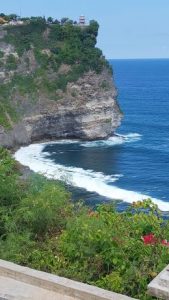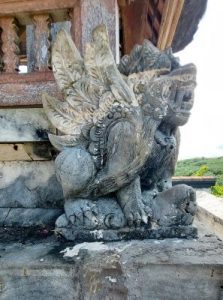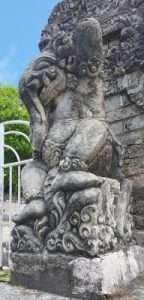
Pura Tanah Lot is a Hindu sea-temple founded in the 16th century and located on Bali’s southern coast. It sits on top of a pedestal of rock that, when the tide is in, becomes an island and is inaccessible from the shore. When the tide is out, a rugged, rocky shelf forms a causeway connecting the temple and its pedestal to the mainland.
My partner and I arrived there one afternoon while the tide was out beyond the temple. The shelf between it and the shore was a messy palette of seaweed-greens and damp-looking greys and browns. Here and there, pools of trapped seawater glinted in the sun like shards of blue glass.

The rock supporting the temple has a froth of vegetation, including trees, growing along its landward side while the temple-buildings are clustered on its seaward side. Flights of stone steps coil up the rock but, when we visited, most sightseers had to be content with wandering about the drained shelf around it. Only a few folk, serious worshippers, were allowed to ascend the steps to the temple itself.


We made our way to the temple’s southern side, mainly to get out of the heat and glare of the afternoon sun, which was so fierce it created a glowing white band across the sea. There, we scrambled up onto a higher level of the shelf, where parts of it were carpeted in mushy brown growths, like pulped kelp. Viewed from this position, the temple and its pedestal had the shape of a sagging haystack. But we couldn’t go the whole way around the temple because we came to a fracture in the shelf, which extended to the bottom of the temple-rock from the ocean. The fracture had created a gorge, with seawater racing tumultuously along its bottom.

Predictably, vendors and pedlars were selling their wares among the throng of sightseers between the temple and the shore. One was hawking kites and had one up in the air, shaped like a galleon with fancy, multicoloured sails. Meanwhile, along the shoreline, at the bottom of the miniature cliffs there, were some cavities that looked like cave entrances. One had a queue of people waiting to go inside and a sign above saying ‘ULAR SUCI – HOLY SNAKE’. This was explained by the temple’s website: “The cave is inhabited by some holy sea snakes, which are believed as (sic) incarnations of shawls of Dang Hyang Nirartha (founder of Tanah Lot Temple).” In other words, Dang Hyang Nirartha is said to have created the sea snakes from his shawl, or sash, to protect the temple against evil spirits.

The ground overlooking Pura Tanah Lot is home to an attractive temple complex. It has well-maintained green spaces and handsome statues that, unlike the discoloured and lichened ones I’ve seen in other Balinese temples, are clad brightly in gold-coloured robes and armour.

Pura Luhur Uluwatu is another of Bali’s famous sea-temples. It’s further south, is located on the western tip of the Bukit Peninsula and was officially established in the 11th century, though a small place of worship may have existed there site earlier.
After the entrance and ticket desk, the approach to the temple was through a pleasantly leafy, wooded area. However, a stark red sign warned us of potential dangers ahead: “BE CAREFUL IN BRINGING ITEMS SUCH AS SUNGLASSES, HATS, HANDPHONES, ETC., BECAUSE THERE ARE MANY MONKEYS IN THIS AREA. IF YOUR STUFF IS TAKEN BY A MONKEY, REACH FOR (sic) OUR OFFICER. DO NOT ATTEMPT TO GET THE STUFF BACK WITHOUT ASSISTANCE FROM OUR OFFICER. The information about the monkeys swiping phones particularly alarmed us. Currently resident in Singapore, our smartphones are laden with important Singaporean ID, banking and transport apps and we’d be screwed if we lost them. So, we agreed that, during our visit, one of us would take photos with their camera-phone while the other kept a lookout for marauding monkeys.
Further on, in the temple complex, we found a sign giving more details about the local monkey population. There are 11 hectares of woodland surrounding the temple, known as Uluwatu Forest, and in it live some 400 grey long-tailed macaques. These are divided into six groups – named riting, tapak, melem, celagi, amplung and gading – whose members range from 50 to 150. The fact they were organised in gangs made them seem more criminal then ever.
The woodland extended right to the temple, so that its grounds were bathed in green-tinted light and rippling shadows. But because the place is perched on a cliff, 97 metres up, this eventually gave way to dramatic views of the Indian Ocean.

Having looked at the temple, we set off down some flights of stone steps and along a path that followed the clifftop to the north. Below, the glassy blue of the sea changed to a mottled blue, white and teal near the shore, and became a turbulent white froth along the rocks at the cliff’s base. The cliffs themselves were largely bearded in green vegetation, with a sprinkling of scarlet flowers at the top. We came to a viewpoint at the path’s end, took some pictures – still guarding against monkeys – and headed back.
While approaching the temple again, we heard ahead of us a chorus of shrieks – female ones. The monkeys had raided a party of Chinese lady tourists. And a few minutes later, back at the temple, we saw one monkey crouching on a wall besides some steps, playing with somebody’s floppy white hat.
Another path ran along the clifftop to the south. It was scenic too but the landscape there was less spectacularly contoured than it was along the northern path.


This temple also contained some interesting statues. There was a crouching, snarling, winged creature, its maw crammed with short tusks, like a canine variant on the Hindu / Buddhist / Jain half-bird, half-human deity Garuda. There was a statue of Ganesha, left arm raised and crooked at the elbow as if scratching his head. I have to say this was the most monstrous representation I’ve seen of this usually genial, elephant-headed deity. The effect was because of his big, blank, boiled-egg-like eyes and his tusks, which were more like fangs, short and thrusting up from his lower jaw.
Finally, there was a statue of the monkey-god Hanuman, in an Action Man pose, wearing battle armour and screaming with exertion. However, lots of little monkeys were swarming around him, climbing up his legs and arms. I know he’s supposed to command a monkey army, but in this depiction it looked more like his minions were attacking him.

Either that, or they were trying to pinch his phone.
